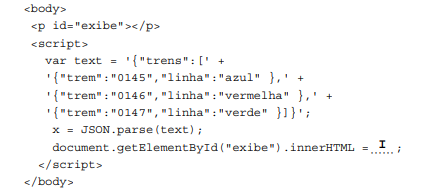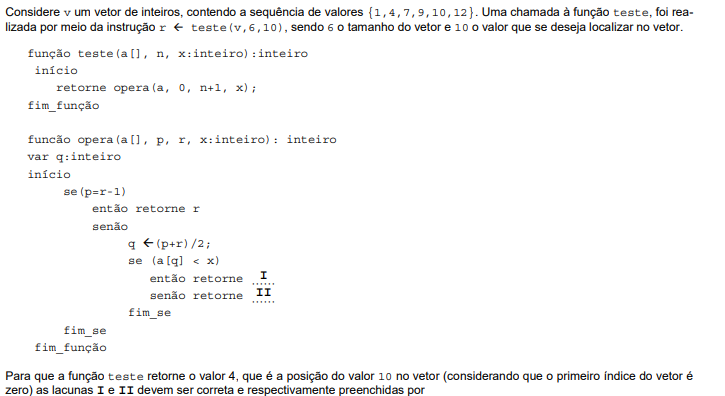Questões de Concurso Público METRÔ-SP 2019 para Analista Desenvolvimento Gestão Júnior – Ciências da Computação
Foram encontradas 60 questões
As massas dos objetos A, B e C satisfazem as seguintes relações:
− as massas de A e B, somadas, excedem em 13 kg a média das massas de B e C;
− subtraindo-se de 79 kg o quádruplo da massa de C, obtém-se a soma da massa de A com o dobro da massa de B.
Assim, a soma das massas de A, B e C, em kg, é igual a
 the Metrorail trains can be crowded with commuters during rush hour and when there is a big event going on downtown,
taking the Washington Metro is usually cheaper and easier than finding a place to park in the city. Several Metro stations are helpful
sightseeing stops.
the Metrorail trains can be crowded with commuters during rush hour and when there is a big event going on downtown,
taking the Washington Metro is usually cheaper and easier than finding a place to park in the city. Several Metro stations are helpful
sightseeing stops.
 the Metrorail trains can be crowded with commuters during rush hour and when there is a big event going on downtown,
taking the Washington Metro is usually cheaper and easier than finding a place to park in the city. Several Metro stations are helpful
sightseeing stops.
the Metrorail trains can be crowded with commuters during rush hour and when there is a big event going on downtown,
taking the Washington Metro is usually cheaper and easier than finding a place to park in the city. Several Metro stations are helpful
sightseeing stops.
The London Underground
The London Underground (also known simply as the Underground, or by its nickname the Tube) is a public rapid transit system serving London, England and some parts of the adjacent counties of Buckinghamshire, Essex and Hertfordshire in the United Kingdom.
The Underground has its origins in the Metropolitan Railway, the world's first underground passenger railway. Opened in January 1863, it is now part of the Circle, Hammersmith & City and Metropolitan lines; the first line to operate underground electric traction trains, the City & South London Railway in 1890, is now part of the Northern line. The network has expanded to 11 lines, and in 2017/18 carried 1.357 billion passengers, making it the world's 11th busiest metro system. The 11 lines collectively handle up to 5 million passengers a day.
Despite its name, only 45% of the system is underground in tunnels, with much of the network in the outer environs of London being on the surface.
As of 2015, 92% of operational expenditure is covered by passenger fares.
Early years
The idea of an underground railway linking the City of London with the urban centre was proposed in the 1830s, and the Metropolitan Railway was granted permission to build such a line in 1854. To prepare construction, a short test tunnel was built in 1855 in Kibblesworth, a small town with geological properties similar to London. This test tunnel was used for two years in the development of the first underground train, and was later, in 1861, filled up. The world's first underground railway opened in January 1863 between Paddington and Farringdon using gas-lit wooden carriages hauled by steam locomotives.
While steam locomotives were in use on the Underground there were I health reports. There were many instances of passengers collapsing whilst travelling, due to heat and pollution, leading for calls to clean the air through the installation of garden plants. The Metropolitan even encouraged beards for staff to act as an air filter. There were other reports claiming beneficial outcomes of using the Underground, including the designation of Great Portland Street as a "sanatorium for [sufferers of ...] asthma and bronchial complaints", tonsillitis could be cured with acid gas and the Twopenny Tube cured anorexia.
During the war many tube stations were used as air-raid shelters. On 3 March 1943, a test of the air-raid warning sirens, together with the firing of a new type of anti-aircraft rocket, resulted in a crush of people attempting to take shelter in Bethnal Green Underground station. A total of 173 people, including 62 children, died, making this both the worst civilian disaster of World War II, and the largest loss of life in a single incident on the London Underground network.
A different kind of accident occurred on 28 February 1975, a southbound train on the Northern City Line failed to stop at its Moorgate terminus and crashed into the wall at the end of the tunnel, in the Moorgate tube crash. There were 43 deaths and 74 injuries, the greatest loss of life during peacetime on the London Underground.
A few years later, on 18 November 1987, fire broke out in an escalator at King's Cross St. Pancras tube station. The resulting
fire cost the lives of 31 people and injured a further 100. London Underground were strongly criticised in the aftermath for their attitude
to fires underground, and publication of the report into the fire led to the resignation of senior management of both London
Underground and London Regional Transport. To comply with new safety regulations issued as a result of the fire, and to combat
graffiti, a train refurbishment project was launched in July 1991.
(Adapted from: https://en.wikipedia.org)
The London Underground
The London Underground (also known simply as the Underground, or by its nickname the Tube) is a public rapid transit system serving London, England and some parts of the adjacent counties of Buckinghamshire, Essex and Hertfordshire in the United Kingdom.
The Underground has its origins in the Metropolitan Railway, the world's first underground passenger railway. Opened in January 1863, it is now part of the Circle, Hammersmith & City and Metropolitan lines; the first line to operate underground electric traction trains, the City & South London Railway in 1890, is now part of the Northern line. The network has expanded to 11 lines, and in 2017/18 carried 1.357 billion passengers, making it the world's 11th busiest metro system. The 11 lines collectively handle up to 5 million passengers a day.
Despite its name, only 45% of the system is underground in tunnels, with much of the network in the outer environs of London being on the surface.
As of 2015, 92% of operational expenditure is covered by passenger fares.
Early years
The idea of an underground railway linking the City of London with the urban centre was proposed in the 1830s, and the Metropolitan Railway was granted permission to build such a line in 1854. To prepare construction, a short test tunnel was built in 1855 in Kibblesworth, a small town with geological properties similar to London. This test tunnel was used for two years in the development of the first underground train, and was later, in 1861, filled up. The world's first underground railway opened in January 1863 between Paddington and Farringdon using gas-lit wooden carriages hauled by steam locomotives.
While steam locomotives were in use on the Underground there were I health reports. There were many instances of passengers collapsing whilst travelling, due to heat and pollution, leading for calls to clean the air through the installation of garden plants. The Metropolitan even encouraged beards for staff to act as an air filter. There were other reports claiming beneficial outcomes of using the Underground, including the designation of Great Portland Street as a "sanatorium for [sufferers of ...] asthma and bronchial complaints", tonsillitis could be cured with acid gas and the Twopenny Tube cured anorexia.
During the war many tube stations were used as air-raid shelters. On 3 March 1943, a test of the air-raid warning sirens, together with the firing of a new type of anti-aircraft rocket, resulted in a crush of people attempting to take shelter in Bethnal Green Underground station. A total of 173 people, including 62 children, died, making this both the worst civilian disaster of World War II, and the largest loss of life in a single incident on the London Underground network.
A different kind of accident occurred on 28 February 1975, a southbound train on the Northern City Line failed to stop at its Moorgate terminus and crashed into the wall at the end of the tunnel, in the Moorgate tube crash. There were 43 deaths and 74 injuries, the greatest loss of life during peacetime on the London Underground.
A few years later, on 18 November 1987, fire broke out in an escalator at King's Cross St. Pancras tube station. The resulting
fire cost the lives of 31 people and injured a further 100. London Underground were strongly criticised in the aftermath for their attitude
to fires underground, and publication of the report into the fire led to the resignation of senior management of both London
Underground and London Regional Transport. To comply with new safety regulations issued as a result of the fire, and to combat
graffiti, a train refurbishment project was launched in July 1991.
(Adapted from: https://en.wikipedia.org)
The London Underground
The London Underground (also known simply as the Underground, or by its nickname the Tube) is a public rapid transit system serving London, England and some parts of the adjacent counties of Buckinghamshire, Essex and Hertfordshire in the United Kingdom.
The Underground has its origins in the Metropolitan Railway, the world's first underground passenger railway. Opened in January 1863, it is now part of the Circle, Hammersmith & City and Metropolitan lines; the first line to operate underground electric traction trains, the City & South London Railway in 1890, is now part of the Northern line. The network has expanded to 11 lines, and in 2017/18 carried 1.357 billion passengers, making it the world's 11th busiest metro system. The 11 lines collectively handle up to 5 million passengers a day.
Despite its name, only 45% of the system is underground in tunnels, with much of the network in the outer environs of London being on the surface.
As of 2015, 92% of operational expenditure is covered by passenger fares.
Early years
The idea of an underground railway linking the City of London with the urban centre was proposed in the 1830s, and the Metropolitan Railway was granted permission to build such a line in 1854. To prepare construction, a short test tunnel was built in 1855 in Kibblesworth, a small town with geological properties similar to London. This test tunnel was used for two years in the development of the first underground train, and was later, in 1861, filled up. The world's first underground railway opened in January 1863 between Paddington and Farringdon using gas-lit wooden carriages hauled by steam locomotives.
While steam locomotives were in use on the Underground there were I health reports. There were many instances of passengers collapsing whilst travelling, due to heat and pollution, leading for calls to clean the air through the installation of garden plants. The Metropolitan even encouraged beards for staff to act as an air filter. There were other reports claiming beneficial outcomes of using the Underground, including the designation of Great Portland Street as a "sanatorium for [sufferers of ...] asthma and bronchial complaints", tonsillitis could be cured with acid gas and the Twopenny Tube cured anorexia.
During the war many tube stations were used as air-raid shelters. On 3 March 1943, a test of the air-raid warning sirens, together with the firing of a new type of anti-aircraft rocket, resulted in a crush of people attempting to take shelter in Bethnal Green Underground station. A total of 173 people, including 62 children, died, making this both the worst civilian disaster of World War II, and the largest loss of life in a single incident on the London Underground network.
A different kind of accident occurred on 28 February 1975, a southbound train on the Northern City Line failed to stop at its Moorgate terminus and crashed into the wall at the end of the tunnel, in the Moorgate tube crash. There were 43 deaths and 74 injuries, the greatest loss of life during peacetime on the London Underground.
A few years later, on 18 November 1987, fire broke out in an escalator at King's Cross St. Pancras tube station. The resulting
fire cost the lives of 31 people and injured a further 100. London Underground were strongly criticised in the aftermath for their attitude
to fires underground, and publication of the report into the fire led to the resignation of senior management of both London
Underground and London Regional Transport. To comply with new safety regulations issued as a result of the fire, and to combat
graffiti, a train refurbishment project was launched in July 1991.
(Adapted from: https://en.wikipedia.org)
search localdomain nameserver 8.8.8.8 nameserver 8.8.4.4
Para editar o arquivo em questão, utilizou a instrução
Considere o fragmento de texto abaixo.
Um dos tipos de sistemas distribuídos em franco crescimento atualmente utiliza criptografia assimétrica para garantir segurança nas transações sem um agente de confiança intermediador. Essas transações são agrupadas e armazenadas em unidades encadeadas e interligadas por meio de códigos hash, de forma que a unidade seguinte indique o hash da unidade anterior. Todas as transações realizadas no sistema são registradas em uma espécie de livro de registros, de acesso público, permitindo a rastreabilidade das transações na rede. Dentre as aplicações desse tipo de sistema distribuído estão as Decentralized Application − DAPP e smart contracts.
O sistema distribuído e o local onde são registradas as transações do sistema são, respectivamente,

Considere o bloco de código abaixo que utiliza JavaScript e JSON.

Para que o bloco de código exiba 0146 vermelha, a lacuna I deve ser corretamente preenchida por
Como o protocolo IP não foi projetado para ser absolutamente confiável, propôs-se o protocolo ICMP para fornecer um retorno sobre os problemas na comunicação.
Nesse contexto, mensagens ICMP são enviadas
I. quando um datagrama não pode alcançar seu destino.
II. quando o gateway não tem capacidade de buffer suficiente para encaminhar o datagrama.
III. quando o gateway pode direcionar o host para enviar o tráfego por um caminho mais curto.
IV. quando é necessário reportar erros ICMP ou descartar pacotes ICMP.
Está correto o que consta APENAS em
